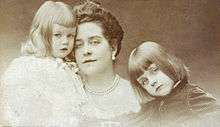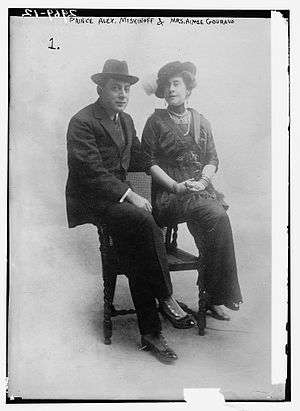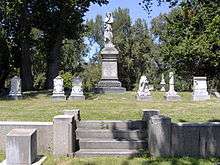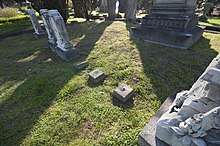Aimée Crocker
Aimée Isabella Crocker (December 5, 1864 – February 7, 1941) was an American princess, mystic, Bohemian, and author. She was known for her cultural exploration of the Far East, for her extravagant parties in San Francisco, New York and Paris, and for her collections of husbands and lovers, adopted children, Buddhas, pearls, tattoos and snakes.
Aimée Crocker | |
|---|---|
 Crocker circa 1890 | |
| Born | Amy Isabella Crocker December 5, 1864 Sacramento, California, U.S. |
| Died | February 7, 1941 (aged 78) New York City, New York, U.S. |
| Resting place | Sacramento Historic City Cemetery |
| Other names | Princess Aimée Isabella Crocker Ashe Gillig Gouraud Miskinoff Galitzine |
| Spouse(s) | Richard Porter Ashe
( m. 1882; div. 1887)Henry Mansfield Gillig
( m. 1889; div. 1900)Jackson Gouraud
( m. 1901; died 1910)Prince Alexander Miskinoff
( m. 1914; div. 1916)Prince Mstislav Galitzine, Count Ostermann
( m. 1925; div. 1927) |
| Children | Gladys Ashe Crocker (b. 11-21-1885 d. 6-27-1947) Reginald Gouraud (b. 3-31-1897 d. 10-22-1963) Yvonne Gouraud (b. 5-1-1899) Dolores Gouraud (b. 7-20-1906) Yolanda Vera Miskinoff (b. 4-11-1915 d. 7-27-1920) |
| Parent(s) | Edwin B. Crocker Margaret Rhodes |
| Relatives | Jennie Louise Crocker Fassett (sister) Charles Crocker (uncle) Charles Frederick Crocker (cousin) George Crocker (cousin) William Henry Crocker (cousin) Henry J. Crocker (cousin) Templeton Crocker (cousin) Harry Crocker {cousin) Bradford Dillman {cousin) |
Early life and family
Crocker was born Amy Isabella Crocker on December 5, 1864, in Sacramento, California, to Judge Edwin B. Crocker and his second wife Margaret (née Rhodes). Crocker was the sixth child in a family of four girls, two boys, and a half sister. Three of the children died young. She was the younger sister of Jennie Louise Crocker Fassett, who was the wife of NY Congressman Jacob Sloat Fassett. Crocker's father was the chief legal counsel for the Central Pacific Railroad and was one of its principal investors along with Mark Hopkins, Collis Huntington, Leland Stanford and brother Charles Crocker, also known as The Big Four. Together they built the western portion of the world's First Transcontinental Railroad. Edwin served briefly as a California Chief Justice. Crocker's mother Margaret is also known for founding Sacramento's Crocker Art Museum, the longest continuously operating art museum in the West with, for a time, the largest private collection in the country.
Crocker was the first cousin of William Henry Crocker, humanitarian and president of three West Coast institutions: the Crocker Bank (once the fourteenth largest bank in the nation), the University of California Board of Regents, and the California Academy of Sciences. When much of the city of San Francisco was destroyed by the fire from the 1906 earthquake, William Crocker and his bank were major forces in financing reconstruction. William's wife Ethel was one of the leading California patrons of French Impressionist art.
Crocker's grandson Gerald Russell was a naturalist, an adventurer and a cryptozoologist who headed several very well publicized expeditions including the Percy Sladen Expedition to Africa, where in the high forests of the British Cameroons, he reportedly encountered a large unclassified animal Mokèlé-mbèmbé, and the Ruth Harkness Asiatic Expedition to Tibet, where he captured the first live giant panda. Russell also led two expansive expeditions in the Himilayas in search of a yeti—the Daily Mail Expedition of 1954 and the Slick Johnson Snowman Expedition of 1958.
In 1875, the ten-year-old Crocker inherited $10 million (approximately $232,818,000 today) when her father "E.B" died.[1][2] In 1880, her mother Margaret decided to send the boy crazy Amy to a finishing school in Dresden, Germany. There she was presented at court and had her first love affair and engagement with Prince Alexander of Saxe Weimar.[3] Crocker broke off the engagement and quickly had a brief entanglement with a Spanish bullfighter. On her return trip to America, Amy became engaged to Charles Gillig, a travel agent and the president of the American Exchange in Paris.[4] When Charles caught her flirting with a young man on a train, he broke off the engagement.[5]
In 1883, Crocker made headlines when she was traveling to Los Angeles on her honeymoon with first husband, Porter Ashe. The train carrying the eloping couple broke loose at the summit of a hill in Tehachapi, killing twenty one people and seriously injuring another twelve. Ashe, whose forefathers had given their name to Asheville, North Carolina and whose uncle was the great Civil War Admiral David Farragut,[6] was credited with pulling people to safety. The New York Times reported that Ashe, “exhibited a great deal of cool heroism at the burning of the cars. After drawing his wife and her maid through the window of the sleeper, he rescued ex-California Governor John G. Downey from between broken timbers, and saved his life.”[7]
Not long after the birth of their daughter, Alma, Crocker and Ashe's marriage collapsed. Ashe plunged into a score of speculations, none of which proved successful. He spent a small fortune on horse racing studs, and then sold off many of them to settle gambling debts. His friendships with actresses Lillie Langtry and Lotta Crabtree were the source of much gossip.[8] The breakup of Crocker's first marriage became a national scandal after Porter and his brother, Sidney, kidnapped Alma in Los Angeles, while Crocker and her mother attended a wedding. Charges and counter charges made daily news during the custody battle. Courthouse proceedings attracted a crowd of hundreds. In spite of Ashe's reputation as a notorious gambler, his kidnapping charge and a weapons charge, he was awarded sole custody of Alma. Crocker was considered the more unsettled of the pair. The child was later adopted by Crocker's mother who changed her name to Gladys.[9]
Life in the Far East
After the public humiliation of losing her child to her ex-husband, Crocker decided to accept an invitation that she got years earlier by King Kalākaua to tour Hawaii, then known as the Sandwich Islands. Kalākaua was so enamored with Crocker that he gave her one of his islands and an official title: Princess Palaikalani—Bliss of Heaven.[10] She found an occasional traveling companion in her second husband, Henry Mansfield Gilling, whom she married in 1889. Gillig was a Commodore, a prestidigitator, and a respected amateur opera singer who cultivated his voice under the Polish master Jean de Reszke.[11]
Crocker's 1936 autobiography, And I'd Do It Again, chronicles many adventures the heiress had while touring the Far East, sometimes with Gillig and sometimes traveling alone including: an escape from headhunters in Borneo, a poisoning in Hong Kong; a murder attempt by knife-throwing servants in Shanghai; three weeks in the harem of Bhurlana (She claimed to be the first English speaking woman who had ever seen the inside of a harem); a search for Kaivalya (Liberation) at the cave of the Great Yogin Bhojaveda in Poona; and two bizarre sensual experiences, one with an Indian boa constrictor, and another with a Chinese violin in "the House of the Ivory Panels."[12] After touring off and on in “the Orient” for over six years she began appearing at social events in San Francisco and New York sporting tattoos, wearing snakes around her neck at parties and declaring her love for the Buddha. Crocker also wrote about her Far East adventures in a book of short stories published in 1910, Moon Madness and Other Fantasies, which her publisher called "arabesques" and she described as "memoirs in fiction form."
During her marriage to Gillig, Crocker had several affairs with powerful Asian men, which were chronicled in her memoirs. She had a three-year affair with literary genius and columnist Edgar Saltus, an internationally known figure of the Decadent movement. Saltus wrote books about Honore de Balzac and the philosophy of Arthur Schopenhauer. He wrote two well received historic novels about the debauchery of the Roman emperors and the Russian czars. Saltus also wrote a tome about the history of atheism. He later became a theosophist.
Life in New York
Crocker met her third husband, songwriter Jackson Gouraud, at a Buddhist colony that she organized (said to be the first in Manhattan). Gouraud wrote the ragtime melodies “Keep Your Eye on Your Friend, Mr. Johnson,” “She's a 'Spectable Married Colored Lady,” “I'se Workin'—I'se Hustlin,” “He's My Soft Shell Crab on Toast,” and “My Jetney Queen.” He set the town singing with the broadly comic number-one hit of his song writing career, “Waldorf-Hyphen-Astoria.” Marrying a showman was controversial at the time to her family and peers as Jackson was considered an "upper servant" at best and beneath the dignity of New York high society. Jackson's father, George Edward Gouraud, was himself an internationally known figure who acted as an agent for Thomas Edison in Europe. He helped found the Edison Telephone Company of London, and a number of European companies using Edison's technology.[13]
Crocker and Gouraud adopted three children, Reginald, Yvonne and Dolores (she would later adopt another daughter Yolanda), and acquired numerous bulldogs. The couple lived in Oriental-themed homes in Manhattan and on Long Island. They also had tattoos of each other's initials inscribed inside coiling snakes. Crocker then reunited with her daughter, Gladys, who went on to marry Gouraud's brother, Powers, making her daughter (who was already legally her sister) a sister-in-law.[14]

The couple became well known Broadway “First Nighters” attending all of the opening nights of the biggest plays at the grandest theaters. Crocker befriended all of the popular performers of the era including Anna Held, David Belasco, John Drew, and the Barrymore family. Her good friend, Italian tenor Enrico Caruso, often visited and sometimes performed at her New York homes.[15] Crocker would eventually be invited to play herself on Broadway at the grand opening of the Folies Bergère Theater in Rennold Wolf's vaudeville “profane satire” piece Hell, with music by Irving Berlin.[16] Another Aimée Crocker inspired character would turn up in a modern society comedy "The Lassoo," by Victor Mapes, a few years later at the Lyceum. Broadway legend George M. Cohan wrote a comedy "Broadway Jones," and a musical "Billie," with an Aimée Crocker character.
The Gourauds made headlines in the early 1900s when their lavish mansion on the Long Island Sound burned to the ground, and when, on another occasion, several of Crocker's prize winning French bulldogs were poisoned. The power couple was known to go on "slumming" tours through the dregs of lower New York City with good friend and self-proclaimed mayor of Chinatown, Chuck Connors, who Crocker claimed silently ruled the Underworld.[17]
Around this time, Crocker began hosting lavish parties that shocked and embarrassed New York's conservative upper crust. She threw a Robinson Crusoe-themed party in Parisian treetops in 1905. At a country circus party at the Hippodrome, then the largest theater in New York, she appeared as a dairy maid and arrived on the back of an elephant. Her co-host that evening was the legendary scallywag/carnival barker Wilson Mizner who would later become a co-owner of the Brown Derby. She knew the Mizner boys from her San Francisco days and was linked romantically in print to Wilson's brother Lans. Another memorable appearance was as Madame de Pompadour, Louis XV's mistress, in a costume party in Paris, and yet another gala that she hosted had her pet boa constrictor, Kaa, as the guest of honor.[18]
Her crowning achievement as “Entertainer of Entertainers” which received press all over the world would be “The Dance of all Nations.” The program that evening featured the very frank “Salome” dance, the curious Vienna Viggle, and the “cannibal” dancer Dogmeena, whose costume consisted of coconut oil and a red sash, and who enthusiastically danced in La Danse des Igorrotes. Crocker, appearing in pearls “that would clothe a baby and ransom a king,” delighted the company when she danced La Madrilena, an Argentine tango (then denounced and forbidden by the Catholic Church) with one of her most recent admirers.[19] A little later, with a twelve-foot snake twined round her neck, she appeared in La Danse de Cobra. When her guests backed away from the snake's emerald eyes and darting tongue, she exclaimed, “It's as gentle as a powder puff."
Because of her frenetic and lascivious lifestyle, Crocker was shunned by much of New York society including some members of her extended family. The public, however, was mesmerized by her. The Philadelphia Inquirer named her "The Most Fascinating Woman of Her Age" [20] and "The Queen of Bohemia." [21] The Bohemian set in New York worshiped her. They were spellbound by the adventurous stories of the well-traveled heiress. They were impressed by her bevy of young male admirers. They were inspired by the guest lists at her gatherings, which were brimming with both illustrious and infamous merrymakers. While many artists and Broadwayites of her time would rent a suite of rooms with a skylight and call it a studio, and while anyone with a little taste and money could furnish their studio with hangings and carvings and risqué paintings, few besides Aimée Crocker Gouraud could induce grand opera prima donnas, maharajas, and senators to mix with highly paid geniuses, men of letters, Broadway showgirls and Bowery scallywags for simple informal afternoon teas. Her homes became a United Nations of enlightenment and entertainment. She sometimes cohosted events with Bohemian artist friend Edmund Russell, who was a well known "Delsartean" lifestyle coach, an actor, an apostle of Madame Helena Blavatsky, and Aimée Crocker's portrait painter.

Later years
In 1910, Gouraud died of an acute attack of tonsillitis. The devastated heiress was hospitalized in Paris. Later that year, a publicity tour for her first book catapulted her into the spotlight. For the next 20 years she was America's most eccentric personality whose every move made headlines. She changed the spelling of her name from “Amy” to “Aimée” for the book and moved her children to an estate in Paris dubbed “The House of Fantasy.” Crocker would live off and on for the next 27 years in the City of Lights, throwing sensational and neurotic parties and housing young artists and exiled Russian nobles. In June 1911, Aimée took Paris by storm after making a splash at a fantastic party thrown by Paul Poiret, a leading French fashion designer and a master couturier. She later lived in an artist colony at Hôtel Biron along with luminaries such as Henri Matisse, Auguste Rodin, Jean Cocteau and Isadora Duncan.[22]
After Gouraud's death, Crocker was romantically linked to many high-profile men including: Eduardo García-Mansilla, the great Argentinean musician, composer and diplomat, with whom she wrote a song Mon Amour; Genia D'Agarioff, opera baritone singer, who is credited with being the first person to sing in the Russian language in London and Paris; composer, performer, designer, director, and arranger Melville Ellis; Jacques Lebaudy, the self-proclaimed “Emperor of the Sahara;” and legendary French actor Edouard de Max, “The Most Beautiful Man in Paris.”[23] Another notable suitor during this period was famous ceremonial magician, occultist, Tantra master and hedonist Aleister Crowley. Crowley wrote about their memorable decade long affair in graphic detail in his journals. He proposed marriage to Crocker nearly every time he saw her or wrote to her.[24]
Though she kept the name Gouraud for the rest of her life, Crocker went on to marry and divorce two more times, both to Russian princes decades younger than her. Her fourth husband, Alexander Miskinoff, caused a stir on two continents when he was accused of having an extramarital affair with Crocker's then 15-year-old adopted daughter, Yvonne. Aimée would marry her fifth and final husband, Prince Mstislav Galitzine, when she was 61 and he was 26. When asked by a friend who lost count of her marriages whether Mstislav was her fifth or sixth husband, she said, “The prince is my twelfth husband if I include in my matrimonial list seven Oriental husbands, not registered under the laws of the Occident.”[25]
Death

,


Crocker died on February 7, 1941.[26] She is interred in the Crocker family plot along with her third husband, Jackson, and two of her daughters in the Sacramento Historic City Cemetery.[27] The brass urns holding both her ashes and the ashes of her third husband, Jackson Gouraud, were stolen.
References
- Plunkett, John., Oakland Tribune, 8 February 1941.
- http://www.bls.gov/data/inflation_calculator.htm
- Plunkett, John. " My Original Nights", Fort Worth Star-Telegram, 7 January 1912.
- "Personal" The Buffalo Commercial 27 May 1882
- "Gotham Gossip" The Times Picayune 20 Mar 1892
- Time, 23 December 1929.
- " The Railroad Disaster", The New York Times, 22 January 1883.
- Brammer, Alex (1987). Victorian Classics of San Francisco, p. xi. Windgate Press, Sausalito, California. ISBN 978-0-915269-05-1.
- " Dropped: The Alma Ashe Case Quietly Connubiated", Los Angeles Times, 6 May 1887, p2.
- Crocker, Aimée (1936). And I'd Do It Again, p.45. Coward-McCann,Inc., New York. ASIN: B001NCFKOA.
- San Francisco Examiner, 15 April 1909.
- Crocker, Aimée (1936). And I'd Do It Again, pp.150-157. Coward-McCann,Inc., New York. ASIN: B001NCFKOA.
- Goddard, Chris. "The 1888 Crystal Palace recordings", 27 November 2004.
- " The Amazing Aimee Gouraud", Philadelphia Public Ledger, 12 February 1922.
- Crocker, Aimée (1936). And I'd Do It Again, p.288. Coward-McCann,Inc., New York. ASIN: B001NCFKOA.
- " Mrs. Gouraud on the Stage", The New York Times, 11 April 1911.
- Crocker, Aimée (1936). And I'd Do It Again, p.269-270. Coward-McCann,Inc., New York. ASIN: B001NCFKOA.
- Crocker, Aimée (1936). And I'd Do It Again, p.269-270. Coward-McCann,Inc., New York. ASIN: B001NCFKOA.
- The Sheboygan Press, 23 January 1912, p7.
- The Philadelphia Inquirer Sun Jul 25, 1937.
- "The Queen of Bohemia is Here" The Philadelphia Inquirer Sun Dec 4, 1921.
- "Kicked Off Parnassus," The Washington Post 8 Oct 1911.
- " Mrs. Gouraud's Next?", The Washington Post, 16 February 1913, p38.
- Kaczynski, Richard (2002). "Perdurabo: The Life of Aleister Crowley," p 324. New Falcon Publications. ISBN 1-56184-170-6.
- " Aimée Crocker Gouraud's 12th Husband So She Says", Oakland Tribune, 17 January 1926.
- "Aimee Crocker, 78, California Heiress, Dies. Five Husbands Included Two Russian Princes". The New York Times. February 8, 1941. Retrieved 2010-07-19.
Princess Aimee Crocker Galatzine, prominent in society and literary circles during the latter part of the last century and heiress to gold and railroad fortunes, died of pneumonia yesterday in her apartment at the Hotel Savoy Plaza. She was 78 years old.
- "Sacramento Historic City Cemetery Burial Index" (PDF). Old City Cemetery Committee. 2005. Archived from the original (PDF) on 2011-06-26. Retrieved April 6, 2011.
Further reading
Taylor, Kevin (2017). Aimée Crocker: Queen of Bohemia, Los Angeles: City of Angels Books. ISBN 978-0-9710530-4-5 Crocker, Aimée (1936). And I'd Do It Again, New York: Coward-McCann,Inc. ASIN: B001NCFKOA